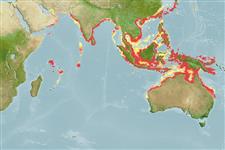Common names from other countries
Environment: milieu / climate zone / depth range / distribution range
Écologie
marin récifal; profondeur 5 - 100 m (Ref. 52753). Tropical; 31°N - 26°S, 47°E - 154°E
Indo-West Pacific: Reported from Persian Gulf (Ref. 68964), coastal waters from Pakistan to Sri Lanka; east coast of India, Taiwan Island, Okinawa in Japan, the Philippines, Papua New Guinea and Australia. Records from South Africa, as Caranx kalla, are based on misidentifications of Alepes djedaba.
Length at first maturity / Taille / Poids / Âge
Maturity: Lm 12.9 range ? - ? cm
Max length : 18.2 cm TL mâle / non sexé; (Ref. 122100); common length : 14.0 cm FL mâle / non sexé; (Ref. 3287)
Adults are found inshore and in coastal waters throughout its range. Feed mainly on planktonic crustaceans and larval fishes. Marketed fresh and dried salted.
Life cycle and mating behavior
Maturité | Reproduction | Frai | Œufs | Fécondité | Larves
Randall, J.E., 1995. Coastal fishes of Oman. University of Hawaii Press, Honolulu, Hawaii. 439 p. (Ref. 11441)
Statut dans la liste rouge de l'IUCN (Ref. 130435)
CITES (Ref. 128078)
Not Evaluated
Menace pour l'homme
Harmless
Utilisations par l'homme
Pêcheries: intérêt commercial mineur
Plus d'informations
RéférencesAquacultureProfil d'aquacultureSouchesGénétiqueElectrophoresesHéritabilitéPathologiesTraitementMass conversion
Outils
Warning: mysqli::__construct(): (HY000/1040): Too many connections in /var/www/html/includes/speciessummary.lib.php on line 2414
Can't connect to MySQL database fbquizv2. Errorcode: Too many connections
